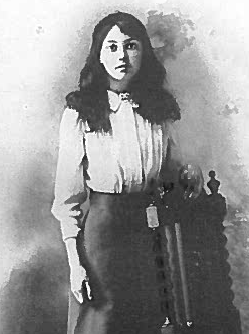|
By Barry Lally Frances Moffett was born during the October Fair of 1900 in a house on the east side of Dunlo Street, Ballinasloe, where Dolan’s electrical goods shop is at present located. The eldest of five children of a Presbyterian family, her father was a vet and her mother a former teacher. In 1985 she published a memoir, “I also am of Ireland”, of the first 24 years of her life. An abridged version of the book was subsequently broadcast in serial form on BBC radio. One of her earliest memories is of seeing the family home crowded with ladies in elegant gowns. In town for the annual Hunt Ball, they were accustomed to call to the house in Dunlo Street to change and rest because it was one of the few in Ballinasloe at the time to boast a bathroom and indoor flush toilet. Up to the age of seven, Frances was educated at home by her mother, after which she was sent to a privately-run Presbyterian school in Mountpleasant. On fine days, Bridget, the family Catholic maid, took her on long walks, which sometimes included surreptitious visits to St. Michael’s Church and the Convent of Mercy. These had to be carefully concealed from her mother who would have strongly disapproved of her young daughter’s frequenting such “places of error and superstition”. Frances recalled how one Sunday her grandfather, a sabbatarian Scot, had angrily pulled down the blinds in his house overlooking the Fair Green to blot out the sight of Catholics “desecrating the Lord’s Day” by playing sports and larking about. Though her parents were fairly tolerant in matters of religion, in some insidious way she soon learnt to almost despise Roman Catholics, and indeed a favourite diversion of hers and her siblings’ was to climb to the top of the back wall of the garden and exchange sectarian taunts in rhyme with the ragged Catholic children of Tea Lane. On 18th December 1908 the family moved to Gentian Hill, a seaside location some miles west of Galway, the train journey taking two and a half hours. Frances attended the High School, an institution under Presbyterian management, but after a year her mother, dissatisfied with the standard of instruction, withdrew her and placed her in the Model School, which was purpose-built for the training of Protestant pupil teachers. The years that followed until the First World War were regarded by Frances as the halcyon days of her life, in spite of some ups and downs. Weather permitting, her free time was usually spent in sea bathing or in botanizing near the shore under her mother’s knowledgeable guidance. A highpoint of those years was a family trip to Dublin on the occasion of the visit of King George V and Queen Mary on 8th July 1911. The royal procession was viewed from a balcony of Clery’s department store on O’Connell Street. Gentian Hill, notwithstanding its attractions, was proving to be unsuited to her father’s practice: it was an inconvenient distance from town and there were no stables where sick animals could be treated and housed. A decision was taken to move to Wellpark near Lough Atalia on the other side of the city. With the outbreak of the Great War, Frances’ father, having volunteered for the Royal Veterinary Corps, was sent to France where he remained for the duration of hostilities. Frances won a place in King Edward VI Grammar School for Girls in Birmingham, and travelled there on 14th September 1914, boarding with her aunt and uncle. She liked the school and was an enthusiastic participant in all out-of-class activities. However, her mother brought her home at the start of the 1915 summer vacation to complete her secondary education in Galway because attacks by German submarines were making the Irish Sea crossing increasingly hazardous and there seemed to be no prospect of an early end to the conflict. When it did eventually end on 11th November 1918, Armistice Day, Frances wore a red, white and blue ribbon in her hair in honour of the occasion. As she wheeled her bicycle up Prospect Hill, a woman emerged from a doorway and flung the contents of a bucket of soapy water in her direction, drenching her skirt and calling her a name that reflected on her moral character. That night several windows in her home were smashed in a fusillade of stones after she and her siblings had hoisted a Union Jack through an attic window. Fortunately the family suffered no further molestation in the turbulent years that followed, if one discounts a fruitless raid for guns and ammunition by Irregulars during the Civil War. In early December 1918, Frances, her mother and younger brother contracted the Spanish flu, with fatal consequences in her mother’s case. She had passed the Irish Senior Grade Certificate, having credits in the right subjects to give her exemption from the entrance examination to Trinity College, but with her mother dead it was now impossible for her to leave home since there would be no one to keep house and care for the younger children. She had the frustrating experience of engaging a series of maids who either had the tiresome habit of becoming pregnant out of wedlock and leaving without giving notice or were hopeless drunkards she had to dismiss. To attend University College Galway a pass in Irish, a subject she had never studied, was necessary. In February 1919, Frances started to learn Irish for the matriculation examination. She tried to enlist the aid of some local native speakers, but these were of little help since they were illiterate in the language. A teacher on the staff of St. Mary’s College was recommended to her, and to avail of his lessons she was obliged to cycle five miles to his home. Frances failed at her initial attempt in June but succeeded in the September exam, and began her first semester in UCG the following month, taking as her subjects for the BA experimental physics, mathematics and English. At that time there was a college official known at the Lady Superintendent tasked with overseeing the appearance, dress, and general conduct of women students both on and off campus. Frances was carpeted by this official who took exception to the way she wore her hair, loose and shoulder-length, as shown in our photograph. She was ordered to adopt a style more appropriate for a female undergraduate. In an effort to conform, Frances pinned up her hair. Next day, however, a mischievous male student, seated behind her in a lecture hall, stuck a ruler in her coiffure, causing the hairpins to fly out and her hair to cascade down, resuming its former aspect. Making her way along College Road in November 1920, Frances was frightened when a motorized patrol of Black and Tans fired a volley of shots over her head. On arrival home she was handed a note from a friend inviting her to tea at 6.00pm when she would be expected to help entertain an unexpected guest. That evening she was shocked to discover that the guest was in fact a Black and Tan. He turned out, however, to be a polite young Scot who told her that he had only joined the force because he could find no other employment, and expressed his utter revulsion at the criminal behaviour of many of his fellow constables. After Frances had graduated in September 1922, to her surprise, she has offered the post of head mistress of the High School where she had already done some part-time teaching. At first she declined, believing she had insufficient experience, but relented when told that the school would have to close for want of suitable staff unless she accepted. Unfortunately, less than two years later she was diagnosed with tuberculosis, a disease that had claimed the lives of three of her maternal uncles before she was born. Three months’ treatment in Switzerland was prescribed, which luckily she had just enough money saved to pay for. Frances left Galway on the first day of 1924, hoping to return at Easter. This was not to be. Her course of treatment in Switzerland completed, she was admitted to a sanatorium in England where she remained teaching the child patients until 1932. She stayed in the teaching profession another four years, then trained for full-time work in the Church of England, later becoming Vice-Principal of a Women’s Theological College. Retiring from church work in 1960, she returned to teaching in schools and a College of Education.
0 Comments
Leave a Reply. |
CLICK HERE to read the Latest Ballinasloe News Articles
June 2024
|
The Town Team was set up by BACD Ltd. to revive the fortunes of Ballinasloe and its hinterland. With the main focus to build on the town’s many strengths, change existing negative perceptions and bring about measurable improvements in the town centre economy and its wider social value.
|
Ballinasloe Area Community Development Ltd.
Ballinasloe Enterprise Centre Creagh Ballinasloe Co. Galway |
All generic photos and images have been sourced and are free of copyright or are clip art images free of copyright. Photos of Ballinasloe have been donated by BEC. If you have any photos that you would like included on the website please email us
Copyright © All rights reserved, 2024 BACD


 RSS Feed
RSS Feed
